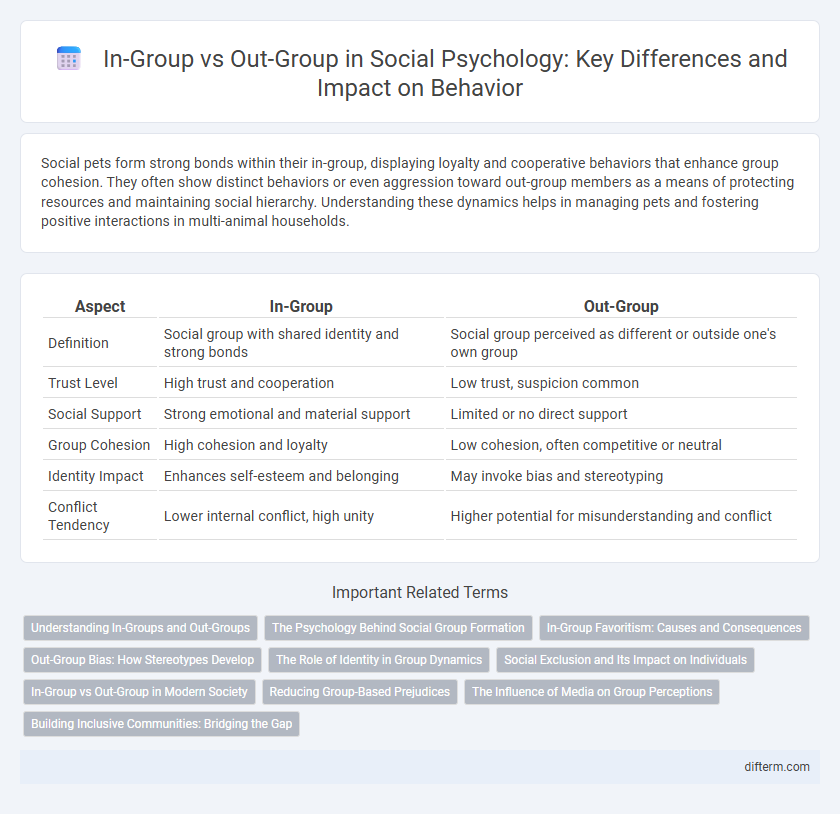Social pets form strong bonds within their in-group, displaying loyalty and cooperative behaviors that enhance group cohesion. They often show distinct behaviors or even aggression toward out-group members as a means of protecting resources and maintaining social hierarchy. Understanding these dynamics helps in managing pets and fostering positive interactions in multi-animal households.
Table of Comparison
| Aspect | In-Group | Out-Group |
|---|---|---|
| Definition | Social group with shared identity and strong bonds | Social group perceived as different or outside one's own group |
| Trust Level | High trust and cooperation | Low trust, suspicion common |
| Social Support | Strong emotional and material support | Limited or no direct support |
| Group Cohesion | High cohesion and loyalty | Low cohesion, often competitive or neutral |
| Identity Impact | Enhances self-esteem and belonging | May invoke bias and stereotyping |
| Conflict Tendency | Lower internal conflict, high unity | Higher potential for misunderstanding and conflict |
Understanding In-Groups and Out-Groups
In-groups are social groups with which individuals identify and share a sense of belonging, often marked by common values, beliefs, or characteristics. Out-groups consist of those outside the in-group, frequently perceived with suspicion or as competitors. Understanding in-groups and out-groups is crucial for analyzing social identity, group dynamics, and intergroup relations.
The Psychology Behind Social Group Formation
Social group formation is influenced by psychological mechanisms such as in-group favoritism, where individuals prefer and prioritize those who share similar traits, values, or identities, fostering a sense of belonging. Out-group perception often triggers bias and stereotyping, as people tend to categorize others as outsiders to maintain social identity and self-esteem. This dynamic is rooted in evolutionary processes that promote cooperation within groups and competition between groups for resources and social status.
In-Group Favoritism: Causes and Consequences
In-group favoritism arises from evolutionary mechanisms that promote cooperation and trust among group members, enhancing group survival and social cohesion. Cognitive biases such as selective perception and motivational biases reinforce positive evaluations of in-group members while fostering discrimination against out-groups. The consequences include amplified social identity, intergroup conflict, and systemic inequalities that affect social dynamics and organizational behavior.
Out-Group Bias: How Stereotypes Develop
Out-group bias arises when individuals categorize others as different from their own social group, leading to generalized negative stereotypes about these out-groups. Psychological mechanisms such as social categorization and confirmation bias reinforce these stereotypes by selectively processing information that aligns with preconceived beliefs. Research in social identity theory and cognitive neuroscience highlights how out-group prejudice is linked to reduced empathy and increased intergroup hostility.
The Role of Identity in Group Dynamics
Identity acts as a pivotal factor in group dynamics, influencing how individuals categorize themselves as part of an in-group or an out-group. This categorization fosters social cohesion within the in-group while often leading to biases, stereotyping, and discrimination against out-group members. The strength of group identity directly impacts conflict resolution, cooperation, and intergroup relations in social environments.
Social Exclusion and Its Impact on Individuals
Social exclusion occurs when individuals or groups are systematically marginalized by the dominant in-group, leading to reduced access to resources, social networks, and emotional support. This exclusion negatively impacts mental health, increasing risks of anxiety, depression, and lowered self-esteem. Research highlights that chronic social exclusion disrupts cognitive functions and diminishes overall well-being, reinforcing social inequalities.
In-Group vs Out-Group in Modern Society
In modern society, in-group dynamics reinforce social identity by fostering trust, cooperation, and shared norms among members, which enhances group cohesion and support systems. Out-group distinctions often lead to stereotyping, exclusion, and conflict, impacting social integration and equality. Understanding these dynamics is critical for promoting inclusivity and reducing social polarization in diverse communities.
Reducing Group-Based Prejudices
Reducing group-based prejudices relies on fostering positive interactions between in-group and out-group members, which can challenge stereotypes and promote empathy. Interventions like cooperative activities and shared goals increase trust and reduce biases by highlighting commonalities rather than differences. Research shows that sustained contact and perspective-taking effectively diminish social barriers and encourage inclusive attitudes.
The Influence of Media on Group Perceptions
Media significantly shapes perceptions of in-groups and out-groups by framing narratives that reinforce stereotypes or biases, often impacting social cohesion and intergroup relations. Repeated exposure to certain portrayals can strengthen group identity or fuel prejudice, influencing behavior and attitudes toward others. Social media algorithms further amplify these effects by creating echo chambers that limit diverse viewpoints and increase polarization.
Building Inclusive Communities: Bridging the Gap
Creating inclusive communities involves recognizing the differences between in-group and out-group dynamics to foster belonging and mutual respect. Strategies such as promoting empathy, encouraging diverse interactions, and implementing equitable policies help bridge social divides. These efforts enhance social cohesion and reduce prejudice by valuing diverse identities within the community.
in-group vs out-group Infographic

 difterm.com
difterm.com